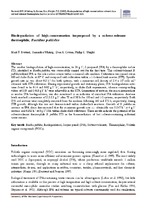Biodegradation of high-concentration isopropanol by a solvent-tolerant thermophile, Bacillus pallidus

View/
Date
2002Author
Bustard, Mark T.
Whiting, Samantha
Cowan, Donald A.
Wright, Phillip C.
Metadata
Show full item recordAbstract
The aerobic biodegradation of high-concentration,
to 24 g l
–1
, 2-propanol (IPA) by a thermophilic isolate
ST3, identified as
Bacillus pallidus
, was successfully carried
out for the first time. This solvent-tolerant
B. pallidus
utilized
IPA as the sole carbon source within a minimal salts
medium. Cultivation was carried out in 100-ml shake flasks
at 60°C and compared with cultivation within a 1-l stirred
tank reactor (STR). Specific growth rate () was about
0.2 h–1
for both systems, with a maximum cell density of 2.4 x 10
8 cells ml–1
obtained with STR cultivation. During exponential
growth and stationary phase, IPA biodegradation
rates were found to be 0.14 and 0.02 g l
–1h–1, respectively, in
shake-flask experiments, whereas corresponding values of
0.09 and 0.018 g l
–1h–1
were achievable in the STR. Generation
of acetone, the major intermediate in aerobic IPA biodegradation,
was also monitored as an indicator of
microbial IPA utilization. Acetone levels reached a maximum
of 2.2–2.3 g l–1
after 72 and 58 h for 100-ml and 1-l systems,
respectively. Both IPA and acetone were completely
removed from the medium following 160 and 175 h, respectively,
during STR growth, although this was not demonstrated
within shake-flask reactions. Growth of
B. pallidus
on acetone or IPA alone demonstrated that the maximum
growth rate () obtainable was 0.247 h–1
at 4 g l–1
acetone
and 0.202 h–1
at 8 g l–1
IPA within shake-flask cultivation.
These results indicate the potential of the solvent-tolerant
thermophile
B. pallidus
ST3 in the bioremediation of hot
solvent-containing industrial waste streams.
